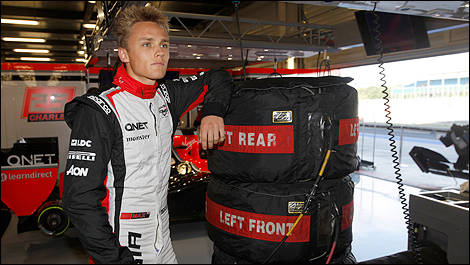Imagine a rookie hockey (or baseball or football) player having a great training camp and then being told: ''Look, you're very talented, and we really like you. Just come back with $2 million (or Euros) and you'll be hired!''
''What? You mean I have to pay to play?''
Sadly, that's the reality in auto racing, even in the über-rich Formula 1: Aspiring drivers must bring tons of cash to the table in order to have a spot.
Of course, motor sports have always been expensive. In fact, in the early 20th Century, auto races almost exclusively involved the wealthy elite, barons, princes and others with blue blood flowing through their veins.
During the 1960s and 1970s, one could still compete in Formula 1 without much money, as evidenced by the likes of Graham Hill, Jim Clark, Jackie Stewart, and Gilles Villeneuve.
However, since the '80s, drivers have had to generate millions for their teams. How exactly? With the financial support of their own family, sponsors or other backers.
Sebastian Vettel has surfed from karting to F1 on a tidal wave of dollars from Red Bull. Bruno Senna and Pastor Maldonado emerged onto the scene with the support of their personal sponsors, while Charles Pic won over Marussia thanks to Groupe Lagardère.
British rising star Max Chilton has recently been elevated from Marussia's Young Driver Program to the position of Formula 1 reserve driver. His father happens to be the vice chairman of Aon, the largest insurance broker in the world.
A rookie season in F1 costs anywhere between $3M and $5M, sometimes even more depending on the team. Rumours of a $10M entry fee for a good, second-tier team have also been floating around.
And then what? If a driver shows enough potential, he may get hired and actually paid by a major team, meaning that he will no longer have to supply money. If not, well, he'd better keep his sponsors in hope of attracting a new team.
Drivers who have yet to take the next step after a few seasons are forced to quit the sport and often handle the load of massive debts.
The 10 years of training in karting, Formula Renault 2.0, Formula 3 and GP2 cost aspiring F1 drivers nearly $5M. That makes hockey and football pretty cheap in comparison, wouldn't you agree?
''What? You mean I have to pay to play?''
Sadly, that's the reality in auto racing, even in the über-rich Formula 1: Aspiring drivers must bring tons of cash to the table in order to have a spot.
Of course, motor sports have always been expensive. In fact, in the early 20th Century, auto races almost exclusively involved the wealthy elite, barons, princes and others with blue blood flowing through their veins.
 |
| Max Chilton, Marussia F1 Team (Photo: Marussia) |
During the 1960s and 1970s, one could still compete in Formula 1 without much money, as evidenced by the likes of Graham Hill, Jim Clark, Jackie Stewart, and Gilles Villeneuve.
However, since the '80s, drivers have had to generate millions for their teams. How exactly? With the financial support of their own family, sponsors or other backers.
Sebastian Vettel has surfed from karting to F1 on a tidal wave of dollars from Red Bull. Bruno Senna and Pastor Maldonado emerged onto the scene with the support of their personal sponsors, while Charles Pic won over Marussia thanks to Groupe Lagardère.
British rising star Max Chilton has recently been elevated from Marussia's Young Driver Program to the position of Formula 1 reserve driver. His father happens to be the vice chairman of Aon, the largest insurance broker in the world.
A rookie season in F1 costs anywhere between $3M and $5M, sometimes even more depending on the team. Rumours of a $10M entry fee for a good, second-tier team have also been floating around.
And then what? If a driver shows enough potential, he may get hired and actually paid by a major team, meaning that he will no longer have to supply money. If not, well, he'd better keep his sponsors in hope of attracting a new team.
Drivers who have yet to take the next step after a few seasons are forced to quit the sport and often handle the load of massive debts.
The 10 years of training in karting, Formula Renault 2.0, Formula 3 and GP2 cost aspiring F1 drivers nearly $5M. That makes hockey and football pretty cheap in comparison, wouldn't you agree?


